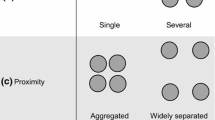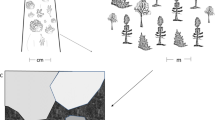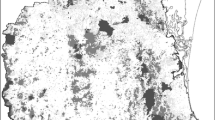Abstract
The optimal spatial design of protected reserves requires attention to the biological mechanisms underlying community organization, and sustaining ecosystem services. Identifying the key mechanisms is especially difficult in species-rich ecosystems. We investigate the example of the tropical rainforest, a biome that is under threat of continuing fragmentation, yet which shelters the majority of living species on Earth. Simple dynamic and spatially explicit simulations, which model the dynamics of plant communities, allow us to elucidate the interplay between patterns of fragmentation and seed dispersal mechanisms in maintaining biodiversity.
Similar content being viewed by others
References
A. Gomez-Pompa, C. Vasquez-Yanes and S. Guevara, The tropical rainforest: A non-renewable resource, Science 177 (1972) 762–765.
A.H. Gentry, Tree species richness of upper amazonian forests, Proceedings of the National Academy of Sciences (USA) 85 (1988) 156–159.
H. ter Steege, D. Sabatier, H. Castellanos, T. van Andel, J. Duivenvoorden, A.A. de Oliveira, R. Ek, R. Lilwah, P. Maas and S. Mori, An analysis of floristic composition and diversity of the Amazonian forests including those of the Guiana Shield, Journal of Tropical Ecology 16 (2000) 801–828.
J. Fjeldså and C. Rahbek, Species richness and endemism in South American birds: Implications for the design of networks of nature reserve, in: Tropical Forest Remnants – Ecology, Management, and Conservation of Fragmented Communities, eds. W.F. Laurence and R.O. Bierregaard, Jr. (The University of Chicago Press, Chicago, 1997) pp. 466–982.
[5] World Bank, World Development Report 1994 (World Bank, Washington, DC, 1995).
A. Grieser Johns, Timber Production and Biodiversity Conservation in Tropical Rain Forests, Cambridge Studies in Applied Ecology and Resource Management (Cambridge University Press, 1997) p. 225.
J.A. Duke, Tropical botanical extractives, in: Sustainable Harvest and Marketing of Rain Forest Products, eds. M. Plotkin and L. Famolare (Island Press, Washington, DC, 1992) pp. 53–62.
O. Phillips, A.H. Gentry, C. Reynel, P. Wilkin and B.C. Gálvez-Durand, Quantitative ethnobotany and Amazonian conservation, Conservation Biology 8 (1994) 225–248.
S.L. Pimm and J.H. Lawton, Planning for biodiversity, Science 279 (1998) 2068–2069.
FAO, State of theWorld's Forests (Food and Agriculture Organization, Rome, 1997).
J.B. Hughes, G.C. Daily and P.R. Ehrlich, Population diversity: Its extent and extinction, Science 278 (1996) 689–692.
R.A. Houghton, D.L. Skole, C.A. Nobre, J.L. Hackler, K.T. Lawrence and W.H. Chomentowski, Annual fluxes of carbon from deforestation and regrowth in the Brazilian Amazon, Nature 403 (2000) 301–304.
C. Körner, Biosphere responses to CO2 enrichment, Ecological Applications 10 (2000) 1590–1619.
A. Cutler, Nested faunas and extinction in fragmented habitats, Conservation Biology 5 (1991) 496–505.
W.F. Laurence and R.O. Bierregaard, Jr. (eds.), Species richness and endemism in South American birds: Implications for the design of networks of nature reserve, in: Tropical Forest Remnants – Ecology, Management, and Conservation of Fragmented Communities (The University of Chicago Press, Chicago, 1997) pp. 466–982.
M.A. Clemens, C.S. ReVelle and J.C. Williams, Reserve design for species preservation, European Journal of Operational Research 112 (1999) 273–283.
C. Kremen, J.O. Niles, M.G. Dalton, G.C. Daily, P.R. Ehrlich, J.P. Fay, D. Grewal and R.P. Guillery, Economic incentives for rain forest conservation across scales, Science 288 (2000) 1828–1832.
L.G. Underhill, Optimal and suboptimal reserve selection algorithms, Biological Conservation 70 (1994) 85–87.
R.L. Pressey, H.P. Possingham and C.R. Margules, Optimality in reserve selection algorithms: When does it matter and how much?, Biological Conservation 76 (1996) 259–267.
J.R. Prendergast, R.M. Quinn and J.H. Lawton, The gaps between theory and practice in selecting nature reserves, Conservation Biology 13 (1999) 484–492.
P.H. Williams and M.B. Araujo, Using probability of persistence to identify important areas for biodiversity conservation, Proceedings of the Royal Society of London B 267 (2000) 1959–1966.
K.M. Virolainen, T. Virola, J. Suhonen, M. Kuitunen, A. Lammi and P. Siikamäki, Selecting networks of nature reserves: Models do affect the long-term outcome, Proceedings of the Royal Society of London B 266 (1999) 1141–1446.
H. Tuomisto, What satellite imagery and large-scale field studies can tell about biodiversity patterns in Amazonian forests, Annals of the Missouri Botanical Garden 85 (1998) 48–62.
D.A. Clark, Deciphering landscape mosaics of neotropical trees: GIS and systematic sampling provide new views of tropical rainforest diversity, Annals of the Missouri Botanical Garden 85 (1998) 18–33.
G. Daily (ed.), Nature's Services. Societal Dependence on Natural Ecosystems (Island Press, Washington DC, 1997) pp. 392.
P. Dasgupta, S. Levin and J. Lubchenco, Economic pathways to ecological sustainability, BioScience 50 (2000) 339–345.
J. Terborgh and B. Winter, A method for siting parks and reserves with special reference to Colombia and Ecuador, Biological Conservation 27 (1983) 45–58.
A.E. Lugo, Management of tropical biodiversity, Ecological Applications 5 (1995) 956–961.
S. Keel, A.H. Gentry and L. Spinzi, Using vegetation analysis to facilitate the selection of conservation sites in eastern Paraguay, Conservation Biology 7 (1993) 66–75.
M.J. Soberón and B.J. Llorente, The use of species accumulation functions for the prediction of species richness, Conservation Biology 7 (1993) 480–488.
C. Kremen, Assessing the indicator properties of species assemblages for natural areas monitoring, Ecological Applications 2 (1992) 203–217.
D.L. Pearson and S.S. Carroll, Global patterns of species richness: Spatial models for conservation planning using bioindicator and precipitation data, Conservation Biology 12 (1998) 809–821.
D.B. Lindenmayer, C.R. Margules and D.B. Botkin, Indicators of biodiversity for ecologically sustainable forest management, Conservation Biology 14 (2000) 941–950.
D. Simberloff, Species turnover and equilibrium island biogeography, Science 194 (1976) 572–578.
B.L. Zimmerman and R.O. Bierregaard, Relevance of the equilibrium theory of island biogeography and species-area relations to conservation with a case from Journal of Biogeography 13 (1986) 133–143.
R. Condit, S.P. Hubbell, J.V. LaFrankie, R. Sukumar, N. Manokaran, R.B. Foster and P.S. Ashton, Species-area and species-individual relationships for tropical trees: A comparison of three 50-ha plots, Journal of Ecology 84 (1996) 549–562.
J.H. Lawton, D.E. Bignell, B. Bolton, G.F. Bloemers, P. Eggleton, P.M. Hammond, M. Hodda, R.D. Holt, T.B. Larsen, N.A. Mawdsley, N.E. Stork, D.S. Srivastava and A.D. Watt, Biodiversity inventories, indicator taxa and effects of habitat modification in tropical forest, Nature 391 (1998) 72–76.
T.J. Givnish, On the causes of gradients in tropical tree diversity, Journal of Ecology 87 (1999) 193–210.
P. Chesson, Mechanisms of maintenance of species diversity, Annual Reviews of Ecology and Systematics 31 (2000) 343–366.
F.R. Adler and B. Nuernberger, Persistence in patchy irregular landscapes, Theoretical Population Biology 45 (1994) 41–75.
S.W. Pacala, C.D. Canham, J.A.J. Silander, R.K. Kobe and E. Ribbens, Forest models defined by field measurements: Estimation, error analysis and dynamics, Ecological Monographs 66 (1996) 1–43.
D.H. Deutschman, S.A. Levin, C. Devine and L. Buttel, Scaling from trees to forests: Analysis of a complex simulation model, Science 277 (1997) 1688.
J. Chave, Study of structural, successional and spatial patterns in tropical rain forests using TROLL, a spatially explicit forest model, Ecological Modelling 124 (1999) 233–254.
D.L. DeAngelis and L.J. Gross (eds.), Individual-Based Models and Approaches in Ecology (Chapman and Hall, New York, 1998).
R. Durrett and S.A. Levin, Spatial models for species-area curves, Journal of Theoretical Biology 179 (1996) 119–127.
S.P. Hubbell, The Unified Theory of Biodiversity and Biogeography, Monographs in Population Biology 32 (Princeton University Press, 2001).
J. Chave, H.C. Muller-Landau and S. Levin, Comparing classical community models: Theoretical consequences for patterns of diversity, American Naturalist, in press.
P. Köhler, J. Chave, B. Riéra and A. Huth, Long-term response of tropical rain forests to the effects of fragmentation, Conservation Biology, submitted.
D.J.D. Earn, S.A. Levin and P. Rohani, Coherence and conservation, Science 17 (2000) 1360–1364.
E.G. Leigh, Jr., S.J. Wright, E.A. Herre and F.E. Putz, The decline of diversity on newly isolated tropical islands: A test of a null hypothesis and some implications, Evolutionary Ecology 7 (1993) 76–102.
P. Beier and R.F. Noss, Do habitat corridors provide connectivity? Conservation Biology 12 (1998) 1241–1252.
K. Riiters, J. Wickham, R. O'Neill, B. Jones and E. Smith, Globalscale patterns of forest fragmentation, Conservation Ecology 4 (2000) 3.
J.G. Liu and P.S. Ashton, FORMOSAIC: An individual-based spatially explicit model for simulating forest dynamics in landscape mosaics, Ecological Modelling 106 (1998) 177–200.
R.D. Holt, S.W. Pacala, T.W. Smith and J. Liu, Linking contemporary vegetation models with spatially explicit animal population models, Ecological Applications 5 (1995) 20–27.
Author information
Authors and Affiliations
Rights and permissions
About this article
Cite this article
Chave, J., Wiegand, K. & Levin, S. Spatial and Biological Aspects of Reserve Design. Environmental Modeling & Assessment 7, 115–122 (2002). https://doi.org/10.1023/A:1015601800181
Issue Date:
DOI: https://doi.org/10.1023/A:1015601800181




